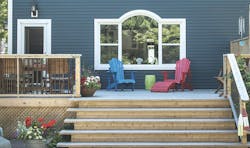Wood vs. Composite Decks
When it comes to selecting the surface material for their outdoor deck, homeowners' options are better looking, better performing and easier to install.
This includes traditional wood decking materials such as pressure-treated pine, redwood, western red cedar, or imported hardwoods; composites made from a blend of reclaimed and recycled materials that typically contain a percentage of wood fiber designed to mimic natural wood without the maintenance; and the newcomer to the market, vinyl — or PVC — decking products that promise a virtually zero-maintenance deck surface but so far have not been able to replicate the beauty of real wood.
All have their pros and cons in terms of appearance and performance that must be considered carefully job-by-job to give customers results that best suit their lifestyle and budget. For this reason, most deck construction specialists work closely with their clients to determine their needs, then specify, design and build what materials best suit the project rather than using a single material.
Natural Wood DecksNatural wood decks continue to be the benchmark for aesthetics. "I'm still a big fan of all wood decks, and my clients still seem to prefer the look of a wood deck," says Dave Tibbetts, owner of Cumming, Ga.-based Atlanta Decking and Fence. "But the reality is that a wood deck requires a good deal of effort in terms of cleaning and sealing to keep it beautiful year after year."
Composite and Vinyl DecksDecks constructed using composite materials are more expensive than natural wood decks, adding about 35 percent to the total cost of the project. But the extra investment can be a worthwhile tradeoff for homeowners who are looking to quickly boost the market value of their home. When using vinyl decks, customers can expect to pay 5 percent more than composite prices. "These low- or no-maintenance decks can be a very good value if the owner is planning to be in their home for more than five years," says Tibbetts, who today builds about 20 percent of his projects using composites.
Nearly 80 percent of clients of deck specialist John Burns, owner of American Deck of Winchester in Winchester, Va., opt for a composite deck. "Our typical composite customer has already had a wood deck in the past, is well aware of the maintenance requirements and does not want to deal with those again," he says. "They come to us requesting composites because they are ready to make the upgrade."
"Composites have come a long way in the past five years," continues Burns. "There have been tremendous improvements in terms of their performance and aesthetics."
Composite materials also bring an added element of design flexibility to a project, says Jim Sasko of Teakwood Builders in Saratoga Springs, N.Y., which really pleases his clients with upscale projects. "You can do some really interesting things like bending the deck around trees much more easily using composites."
Sasko builds about 90 percent of his deck projects using composite materials and reserves all-wood decks for sheltered, undercover applications such as gazebos, screened porches and three-season rooms.
Installation, presentation challengesAll decks — wood, composite or vinyl — are constructed on a pressure-treated wood foundation, but design and installation techniques vary. Experience is the best teacher.
"There definitely is a learning curve associated with working with composites and vinyls as you make the changeover from building all-wood decks," says Burns. The most important thing to keep in mind, he says, is in the planning of the deck: "The spans must be designed correctly depending on the surfacing material that you are using."
"Composites require a slightly beefier substructure to handle the spans," agrees Eric Kent, president of Archadeck of Charlotte. "Composites require 12-inch on center construction as opposed to 16-inch on center for wood."
Hidden fastening systems, which eliminate the appearance of screws or other hardware on the deck surface are available for both wood and composite decks and becoming more popular and user-friendly these days, says Burk. "Nobody really wants to look at fasteners."
"Use of hidden fasteners really takes the appearance of the deck so much further than just the use of colored screw heads, which is what we did in the past," he says. "Almost all composite manufacturers have developed or improved upon their own hidden fastener solutions these days. Because they are designed to be used with the manufacturer's pre-grooved deck boards, they can really save a lot of installation time once you are familiar with the product."
"Do your homework," advises George Drummond of Casa Decks in Virginia Beach, Va., "particularly when experimenting with new products or materials, including the new hidden fastening systems." Drummond says that he uses hidden fasteners on about 30 percent of his projects. A simple mistake such as over tightening the screw in the fastener can ruin its integrity.
"The most important thing is to make sure that you read and understand all of the manufacturer's instructions on how to install any decking product before you start the project because that can make all the difference. Remember, it is your reputation that is on the line as well."
Installation tips for different types of deckingWood Decking- Minimize the spacing between boards to account for material to shrink with weathering.
- Use fastening systems that are compatible with the wood species, sealers and preservatives.
- Consider diagonal installations to minimize splices and add visual interest.
- Check code approval in your area.
- Understand the framing requirements for spans during the design stage of the project.
- Use only manufacturer-approved fastening systems.
- Recognize these materials can not be used for structural framing.
- Consider how you will finish the edges of the deck, treads and risers.
